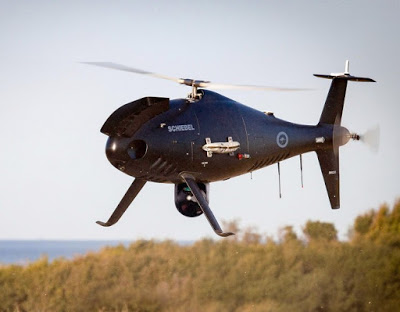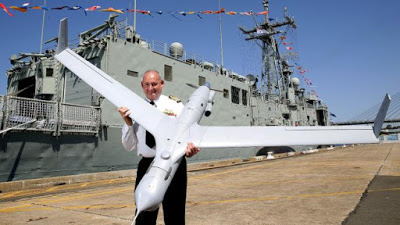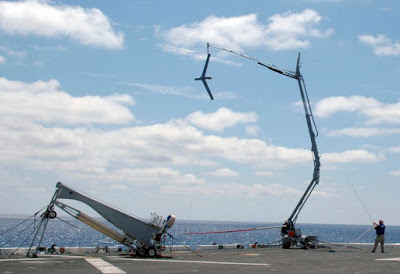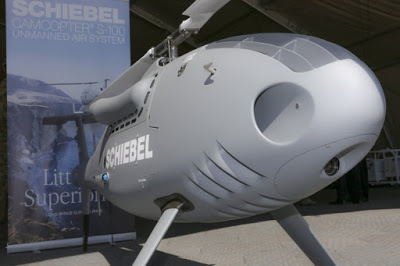RAN"s Eyes in the Skies
RAN"s Eyes in the Skies
08 Maret 2017
Schiebel Camcopter S-100 rotor-wing UAV (photo : DTR Magazine)
Navy"s Avalon eyes in the skies
Not all aircraft at the Australian International Airshow at Avalon actually have pilots – just ask the team at the Navy Unmanned Aircraft Systems Unit.
The Unit is tasked with trialling and testing two different unmanned aircraft types – the ScanEagle (fixed wing) and the Schiebel Camcopter S-100 (rotary wing) for the Royal Australian Navy.
ScanEagle has been operated in the HMAS Choules and HMAS Newcastle (photo : news)
Lieutenant Commander Matt Hyam is the Engineering Manager in charge of the maintenance and engineering of both unmanned aircraft systems.
Most of the staff at the unit are aviation technicians, specialising in avionics or airframes.
“We only have a very small team here at Avalon this year because a lot of our technicians are currently undergoing world-class training with Schiebel in Vienna, Austria, for two months,” Lieutenant Commander Hyam said.
Chief Petty Officer Aviation Technician Aircraft Simon Hustwit is responsible for technical aspects of the project and is assisting in the tent at Avalon.
Insitu ScanEagle fixed-wing UAV (photo : suav)
He has been answering a lot of questions about both aircraft.
“The ScanEagle is a fixed-wing, unmanned aircraft focused on providing commanders with a vital intelligence, surveillance and reconnaissance capability, providing a more complete battle picture,” Chief Petty Officer Hustwit said.
“At sea, the ScanEagle operates well beyond the range of a warship’s organic sensors, providing a vital eye in the sky,” Chief Petty Officer Hustwit said.
The ScanEagle has been trialled by the Navy for about 18 months, with first of class trials conducted in HMA Ships Choules and Newcastle.
Schiebel Camcopter S-100 at Avalon Airshow (photo : RAN)
This is the first time the Navy have displayed the , which looks like a mini helicopter, so it is drawing the biggest crowd.
“The main advantage of the Schiebel is its vertical take-off and landing capability, which saves on the deck space that would be required for a launcher,” he said.
Information from the trials of both unmanned aircraft types will guide the acquisition of a mature unmanned aerial system for the fleet in the early 2020s.
Lieutenant Commander Hyam said the unmanned systems were often the safest choice.
“The rationale is that if a job is dull, dirty or dangerous, then an unmanned system is the right platform for the job.”
(RAN)
Militer Indonesia
08 Maret 2017
Schiebel Camcopter S-100 rotor-wing UAV (photo : DTR Magazine)
Navy"s Avalon eyes in the skies
Not all aircraft at the Australian International Airshow at Avalon actually have pilots – just ask the team at the Navy Unmanned Aircraft Systems Unit.
The Unit is tasked with trialling and testing two different unmanned aircraft types – the ScanEagle (fixed wing) and the Schiebel Camcopter S-100 (rotary wing) for the Royal Australian Navy.
ScanEagle has been operated in the HMAS Choules and HMAS Newcastle (photo : news)
Lieutenant Commander Matt Hyam is the Engineering Manager in charge of the maintenance and engineering of both unmanned aircraft systems.
Most of the staff at the unit are aviation technicians, specialising in avionics or airframes.
“We only have a very small team here at Avalon this year because a lot of our technicians are currently undergoing world-class training with Schiebel in Vienna, Austria, for two months,” Lieutenant Commander Hyam said.
Chief Petty Officer Aviation Technician Aircraft Simon Hustwit is responsible for technical aspects of the project and is assisting in the tent at Avalon.
Insitu ScanEagle fixed-wing UAV (photo : suav)
He has been answering a lot of questions about both aircraft.
“The ScanEagle is a fixed-wing, unmanned aircraft focused on providing commanders with a vital intelligence, surveillance and reconnaissance capability, providing a more complete battle picture,” Chief Petty Officer Hustwit said.
“At sea, the ScanEagle operates well beyond the range of a warship’s organic sensors, providing a vital eye in the sky,” Chief Petty Officer Hustwit said.
The ScanEagle has been trialled by the Navy for about 18 months, with first of class trials conducted in HMA Ships Choules and Newcastle.
Schiebel Camcopter S-100 at Avalon Airshow (photo : RAN)
This is the first time the Navy have displayed the , which looks like a mini helicopter, so it is drawing the biggest crowd.
“The main advantage of the Schiebel is its vertical take-off and landing capability, which saves on the deck space that would be required for a launcher,” he said.
Information from the trials of both unmanned aircraft types will guide the acquisition of a mature unmanned aerial system for the fleet in the early 2020s.
Lieutenant Commander Hyam said the unmanned systems were often the safest choice.
“The rationale is that if a job is dull, dirty or dangerous, then an unmanned system is the right platform for the job.”
(RAN)
Militer Indonesia




Comments